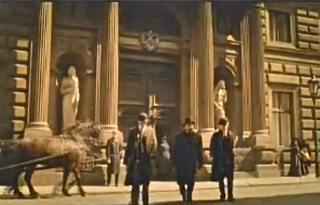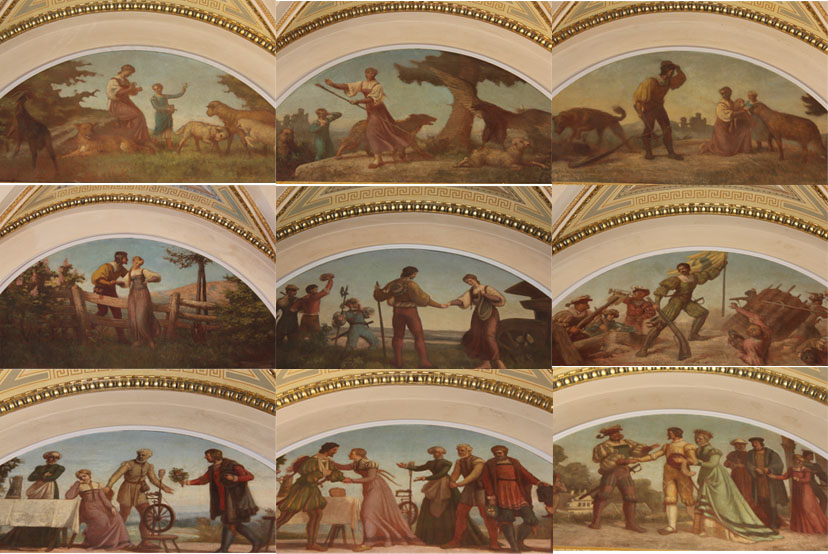With no doubts, the environment is a very important element of our life. Culture we grow in shapes us as personalities. People we interact with may cardinally change our vision of the world. It would not be a surprise for you to learn that even the difference in climates can partially explain why Italians are so different from Swedes. But does the spirit of the building we work in matter? Let’s hope it does as the CERGE-EI building is associated with Angels.
Back to the times of Charles IV (1346-1378), the street where the CERGE-EI building is located nowadays was called the Angel’s Street. It was not a street as such, as there was just a single house surrounded by a big garden on it. A real Angel lived in that house. He was a pharmacist and saved many lives, thereby deserving to be called the Angel. Several centuries after, people still give credit for all his deeds: many pharmacies in Prague are adorned with angels.
Nothing is everlasting, and the Angel’s house has been eventually demolished. Instead of it, a big palace has been constructed. Shortly after its construction, the palace was given to Josef Breda, the Royal Governor of the Old Town, as a reward for valorous fighting in the times when Prague was sieged by the Prussian Army.
This was the XVIII century, the time of gorgeous balls. It is easy to imagine many of these balls happening in the palace, bringing women in beautiful dresses with perfumed lace and men in elegant suits with curled mustache into the building. Life makes circles, and there have been balls happening in the CERGE-EI building during the last two decades as well! These balls were not real though. They were parts of such movies as Illusionist (2006), From Hell (2000), Zvidočelá země (1995), Sans Famille (2000) and many others that were shot in the CERGE-EI building. Is not it cool to recognize rooms where the main actions of movies like these take place?
Unfortunately, the palace was destroyed by fire in 1757. The remains were purchased by the Merciful Brethren and were turned into a convent hospital. Later, the Austrian Empress Maria Teresa bought the building and converted it into a facility to accommodate some of the many orphans created by the famine and plague of 1771. This kind act shows that the spirit of Angel has not leave the building: again it was the place where people came for treatment, and children found home. Would you disagree that the same is happening in the CERGE-EI building nowadays?
In the XIX century Baron Jan Schebek commissioned architect Ignac Ullman to build a sandstone and marble house on the place of orphanage. The building got the name “The House of the Angel”. A marble staircase led to public rooms decorated with the scenes from Olympus, symbols of Art and Science. At CERGE-EI, these rooms are used for research seminars and presentations that greatly corresponds to their decoration. Do you think Baron Schebek could foresee the future of the building when he was deciding about its design?
Baron Schebek also left us another heritage – the love story, which you can observe in room no.7 on the paintings of Ten Lunets by Victor Barvitius. On the paintings, two miller’s daughters are herding sheep when an eagle attacks the favorite sheep of the elder daughter. Suddenly a handsome gamekeeper comes to rescue the sheep. This man and elder daughter fall in love with each other. Shortly, the war departs the loving couple. While the young man is fighting the enemies with bravery and heroism, the girl’s father arranges her marriage with a wealthy man. The Angel helps the loving couple here. He brings the young man back home distinguished for all his valor services in the war. This makes it possible for the two to marry and to live together happily ever after.
In 1890 Baron’s son sold the house to the Austro-Hungarian Bank. In 1918, after the founding of the First Republic (independent Czechoslovakia), the building became the headquarters of the State Bank of Czechoslovakia. The money enterprise has not moved too far away from the building. You can observe the process of money printing from the window in one of the 3rd floor rooms during your lectures or exercise sessions.
During World War II the Angel Street became a witness of numerous acts of Nazis’ cruelty. Fortunately, they didn’t happen inside the House of the Angel. In the post war period, the street was renamed in the honor of whose victims and from that time on it bears the name “Street of Political Prisoners”.
In 1963, ownership of the building was transferred to the Czechoslovak Academy of Sciences, which made it the seat of its Institute of Economics. The Academy of Sciences of the Czech Republic is still the owner of the building, and CERGE-EI is proud to occupy “The House of the Angel.”
As Richard E. Quandt mentions in his book “The changing Landscape in Eastern Europe: A Personal Perspective on Philanthropy and Technology Transfer” (2002) there were a couple of alternatives where to locate CERGE-EI, and “The House of the Angel” was not the original choice. Nevertheless, CERGE-EI has been moved to the building created by Baron Schebek to be the home of science at the place Angel still takes care of.
Iuliia Brushko, 3rd year CERGE-EI student



